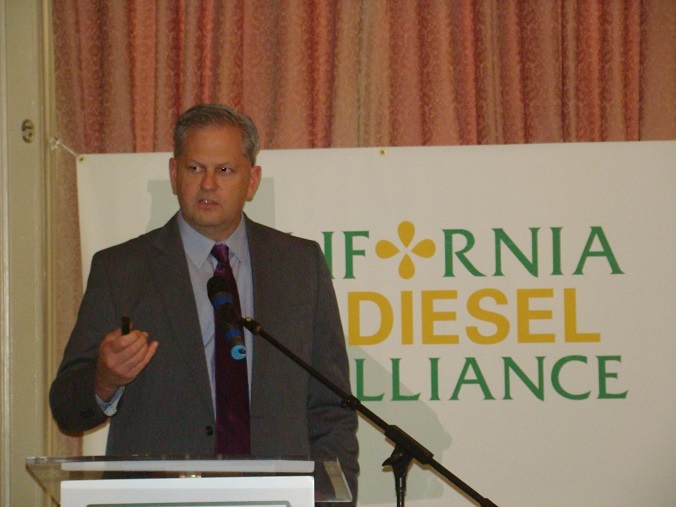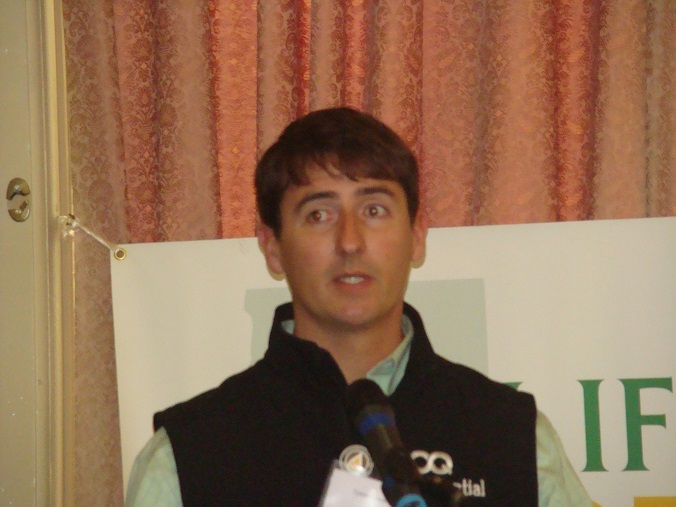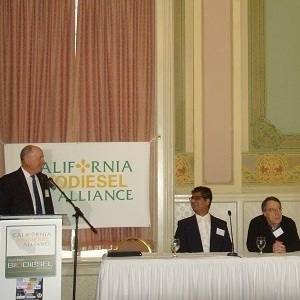CBA event highlights California's thriving biodiesel market




Photo: Ron Kotrba, Biodiesel Magazine
March 9, 2017
BY Celia DuBose, the California Biodiesel Alliance
Jennifer Case, chair of the California Biodiesel Alliance, ended her opening address at the sixth annual California Biodiesel Conference March 1 in Sacramento with one simple message: The world of biodiesel is trending up. While not shying away from challenges to the state’s industry, Case focused on the good news that the state has survived recent threats to its low carbon fuel standard (LCFS) and has seen credit values rise as a result. She said it’s time to celebrate the opportunity for soy and biodiesel imported from other states to help meet current LCFS demand and the demand that will be created by aggressive targets beyond 2020 under SB 32, which calls for an overall economy-wide greenhouse gas (GHG) reduction of 40 percent by 2030 compared to 1990 levels.
Moderated by Curtis Wright, the Biotane Fuels division manager for Imperial Western Products, the first panel focused on biodiesel’s famously low carbon intensity. Anil Prabhu, manager of California Air Resource Board’s fuels evaluation section, discussed how biodiesel feedstocks determine carbon intensity (CI) scores under LCFS’s lifecycle analysis and the tools used to determine the “direct” and “indirect” effects on those scores. He mentioned LCFS considerations for biodiesel in 2019, including updating CA-GREET, seeking feedback on transport distance for feedstock sourcing, facility-specific rendering energy, and mandatory third-party verification of producers’ CIs, especially for used cooking oil (UCO).
Don O’Connor of (S&T)2 Consultants Inc. presented a detailed look at the universe of factors that determine the CI of biodiesel. He cited a need for better information on transportation distances for UCO and listed some opportunities for lowering CI scores, including renewable natural gas (the biggest opportunity), renewable methanol, and potentially using distillation bottoms for fuel.
With a focus on ARB’s new rulemaking, Shashi Menon, managing partner at EcoEngineers, praised the LCFS and called the proposed verification program a step in the right direction. He offered some of his thoughts about how to reduce risk in the credit marketplace and how to regulate, monitor and help verification bodies—all toward the goal of letting the clean fuels sector focus on production.
Don Scott, the director of sustainability for the National Biodiesel Board, presented information about recent improvements in land use change (LUC) modeling that are showing decreases in the indirect LUC penalties of most biofuels, including soy biodiesel. Stating that, globally, we are feeding more people and using less land to do so, he ended by calling it a convenient truth that “when we grow protein to feed the world, we get more fat than we can eat. This is a natural and abundant form of stored solar energy.”
Key California biofuels policies were covered in the next panel moderated by Russ Teall, the president and founder of Biodico Sustainable Biorefineries. Floyd Vergara, the chief of ARB’s industrial strategies division, presented a broad overview of the state’s complex suite of regulations, directives and legislation designed to meet its climate targets, including the scoping plan, the LCFS, and the alternative diesel fuel regulation (ADF), which currently affects only biodiesel. The ADF regulation requires reporting by producers, importers and blenders beginning Jan. 1, 2016, and will require new reporting on Jan. 1, 2018, to include the method of nitrogen oxide (NOx) control. He said that LCFS and ADF provide a “durable framework” for lowering the CI of transportation fuels to 2020 and beyond and cited biomass-based diesel fuels’ significant environmental and human-health benefits, specifically the importance of particulate matter (PM) reductions in environmental justice (EJ) communities.
Tim Olson, energy resources manager at the California Energy Commission, pointed out potential competition for funding from his agency facing biodiesel from refinery co-processing, biomethane, low-NOx natural gas and renewable diesel. Citing the GHG emissions reduction potential of commercial-scale agency projects, he presented a scenario of 10 alternative diesel projects using waste oils with an average 81 percent GHG reduction and total annual capacity increase of 74.9 million diesel-gallons-equivalent per year.
Advertisement
CBA’s lobbyist Louie Brown discussed the group’s targeted legislative and regulatory work, including a focus on the priority effort to secure cap-and-trade auction proceeds for instate biofuels production incentives.
Allan Morrison, a senior scientist with the California Department of Food and Agriculture’s measurement standards division, covered biodiesel-related programs, highlighting updates to the inedible kitchen grease program and biodiesel dispenser labeling requirements. He said he would work with the state industry to address labeling challenges potentially posed beginning Jan. 1, 2018, by the ADF regulation’s seasonal limits.
Moderated by CBA Vice President Joe Gershen, the panel Thriving in the California Biodiesel Market: Risk Management Strategies brought three experts with deep experience in the full-time, complex job of managing risk with fuels and other commodities, which requires balancing science, math, intuition, creativity and a bit of luck. Billy Burns, energy risk management consultant with INTL FCStone Inc., Paul Oesterreich, renewables sales executive for World Fuel Services, and David Dunn, compliance and renewables manager with Idemitsu Apollo, discussed the several additional levels of complexity of the California biodiesel industry, which involves physical product, renewable identification number (RIN) and LCFS credits, and uncertainty about whether the federal tax credit will be reinstated. Each shared their pragmatic approach to how to manage risk and thrive in the Golden State.
Keynote speaker, Dean Perez, an ARB member, gave a decidedly upbeat address that touched on the benefits of biodiesel, including GHG and PM reductions, and the need for higher blends. Every bit the biodiesel champion, he was optimistic about biodiesel’s role in helping the state reach its climate goals and encouraged the state’s industry to continue to work closely with his agency and to reach out to the EJ community on the state’s scoping plan.
Donnell Rehagen, CEO of the NBB, presented a comprehensive overview of the federal biodiesel industry. Citing the NBB’s “10x22 Vision” for biodiesel to comprise 10 percent of diesel fuel demand by 2022, he updated attendees on the Renewable Fuel Standard and the federal tax credit, the market drivers behind that goal. Among the range of opportunities and challenges for biodiesel at the different regional levels, he pointed out the staggering potential of California’s LCFS to catapult biodiesel and renewable diesel demand from several hundred million gallons today to 1.6 billion gallons by 2030.
Tyson Keever, president and CEO of SeQuential, both moderated and presented on the panel SB 32: A New Era for California Markets and Beyond. Passionate about his state’s need to address climate change, he focused on Oregon’s clean fuel program. The program, which was fully implemented beginning in 2016 and calls for a 10 percent reduction of average CI in 10 years, still needs to resolve issues related to cost containment, rules for small vs. large importers, retroactive credit generation and more.
Ian Thomson, president of Advanced Biofuels Canada, detailed how under climate action and clean tech growth plans, Canada’s federal government, and several provincial governments, are developing renewable and clean fuel standards. Regulations promoting biofuels are being updated and new ones are being proposed with industry consultation underway. This is occurring in Quebec, Ontario, Alberta, and British Columbia, the provinces where 85 percent of Canada’s fuels are sold, offering significant growth opportunity for biofuels.
Advertisement
In presenting scenarios for meeting the proposed 18 to 25 percent CI reductions by 2030 under LCFS as part of compliance with SB 32, Shelby Neal, NBB’s director of state governmental affairs, discussed his view of a more realistic scenario than that put forward in the state’s biofuel supply module, which relies heavily on electric vehicles, biomethane and hydrogen adoption. His bottom line: California should not limit biodiesel to 20 percent or play favorites between biodiesel and renewable diesel, because the state is going to need all of those fuels it can get.
The panel The Best Biodiesel Writers in Open Dialogue wrapped up the day. The audience was treated to a discussion with Ron Kotrba, editor of Biodiesel Magazine, Tina Caparella, editor and publisher of Render Magazine, and Bob Lane, vegetable oil, biodiesel and grain editor for The Jacobsen. In response to questions from moderator Celia DuBose, CBA’s executive director, there was general agreement about support for policies favoring domestic fuel and a producers tax credit, as well as concern about biodiesel policies under the Trump administration. The panelists, who read a huge amount of material to stay current in the field, cited the value of learning about both the very big picture of global trends and the nitty gritty of daily life in the industry from personal discussions with industry members.
As a very fitting end to the day, and to answer the question about what our industry can do better, the writers enthusiastically urged attendees to tell their stories and to include details about the jobs the biodiesel industry is creating, the vendors companies are working with, the technology being used—all of it.
CBA wishes to thank the following for their generous conference sponsorship: the NBB and Renewable Energy Group Inc. (Gold); Crimson Renewable Energy (Silver); and Biodico, Chemol Company, and the Sustainable Biodiesel Alliance (Bronze). CBA recognizes, with special thanks, its partner sponsors: the NBB (Gold); Argus, Baker Commodities, and EcoEngineers (Silver); and ACT, Evonik and The Jacobsen (Bronze).
Author: Celia DuBose
Executive Director, California Biodiesel Alliance
916-583-8015
celia.dubose@cabiodieselalliance.org
Related Stories
Reps. Mike Flood, R-Neb., and Troy A. Carter, Sr., D-La., on July 21 reintroduced the SAF Information Act. The bill directs the U.S. EIA to more explicitly include SAF data in its weekly and monthly reports.
The U.S Department of Energy Bioenergy Technologies Office, in partnership with the Algae Foundation and NREL, on July 21 announced the grand champion and top four winning teams of the 2023 - 2025 U.S. DOE AlgaePrize Competition.
The European Commission on July 18 announced its investigation into biodiesel imports from China is now complete and did not confirm the existence of fraud. The commission will take action, however, to address some systemic weaknesses it identified.
Kintetsu World Express Inc. has signed an additional agreement with Hong Kong, China-based Cathay Pacific Airways for the use of sustainable aviation fuel (SAF). The agreement expands a three-year partnership between the two companies.
On July 18, U.S. EPA announced a reduction in force (RIF) as the agency continues its comprehensive restructuring efforts. With organizational improvements, EPA is delivering $748.8 million in savings.
Upcoming Events










